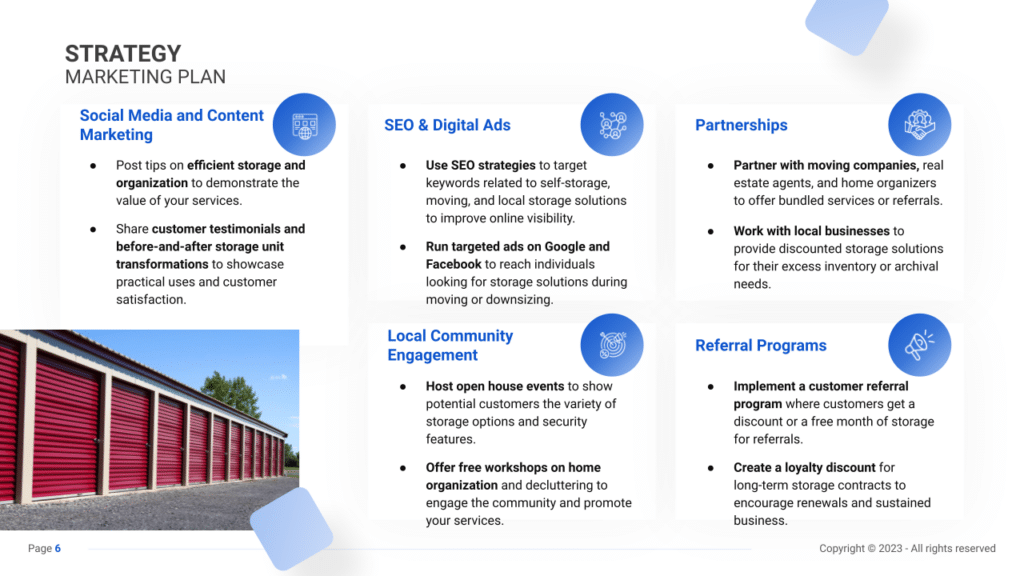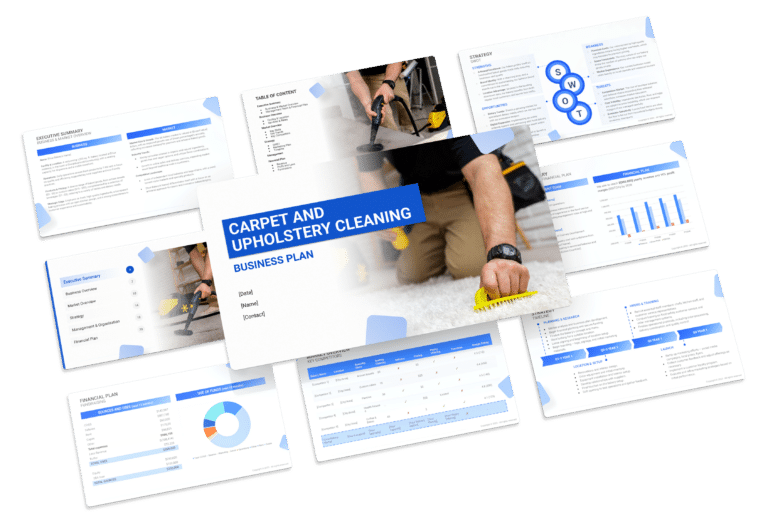Sales & Marketing Plan for a Self-Storage Business

Operating a successful self-storage business requires more than providing space; it demands a well-crafted sales and marketing strategy tailored to the unique demands of the industry. This comprehensive guide will help you formulate a customized sales and marketing plan for a self-storage facility’s business plan.
Starting with a thorough market analysis, understanding competitors and customer needs is paramount for a successful strategy. Next, we’ll focus on establishing your facility’s brand identity and positioning it strategically in the market to stand out.
Exploring various marketing channels, including digital platforms, traditional advertising, and community engagement, is vital for reaching potential customers effectively.
Lastly, we’ll dive into diverse sales strategies tailored to the self-storage business model. Efficient sales channels and loyalty programs will be explored to boost revenue and ensure long-term success. Let’s dive in!

Market Analysis
A robust market analysis is the foundation upon which your business strategy stands. It’s essential to comprehend the nuances of the market landscape to make informed decisions.
Competitive Analysis
- Identify Competitors: Begin by conducting an exhaustive review of other self-storage facilities in your immediate vicinity and nearby areas. Scrutinize their offerings, pricing models, and various unit sizes available for rent. Note their customer service benchmarks, security features, and any unique selling points (USPs) they emphasize.
- SWOT Analysis: After gathering detailed information on competitors, proceed to conduct a thorough SWOT analysis for your self-storage facility. Assess your facility’s Strengths, Weaknesses, Opportunities, and Threats concerning these competitors. Identify aspects where your facility excels, areas needing improvement, potential growth opportunities, and possible threats that competitors pose.
Target Audience Profiling
Understanding your potential customers is crucial for tailored marketing strategies:
- Demographics and Psychographics: Segmentation goes beyond basic demographics. Consider lifestyle preferences, storage habits, and reasons for seeking storage solutions. This granular insight is invaluable in crafting resonant marketing messages.
- Customer Requirements: Go beyond what customers want; understand why they need storage. Whether it’s due to moving, downsizing, seasonal changes, or business purposes, knowing their motivations shapes your marketing tone and content.
Branding and Positioning
Crafting a strong brand identity is imperative for standing out in the market:
Brand Identity Development
- Establishing Core Values: Refine your brand story to illustrate how your facility fills gaps in the market. Emphasize the personal stories behind the facility’s establishment, emphasizing trustworthiness and reliability.
- Visual Elements: The visual identity should extend beyond the logo and color schemes. Consider the facility layout, lighting, and overall ambiance. Create a consistent experience that aligns with your brand message.
Market Positioning Strategy
Defining your unique selling points and brand perception:
- Unique Selling Proposition (USP): Identify and highlight what sets your storage facility apart. Whether it’s cutting-edge security systems, round-the-clock accessibility, specialized storage options, or exceptional service, focus on these differentiators.
- Positioning Statement: Craft a clear and compelling positioning statement encapsulating the essence of your facility. This statement should define how you want your brand to be perceived and guide your marketing strategies.
Marketing Channels
Utilizing diverse marketing channels to reach and engage potential customers:
Digital Marketing
- Website and SEO: Develop a professional website showcasing your storage options, security measures, location details, and transparent pricing. Prioritize a seamless user experience (UX) and mobile responsiveness. Optimize your website for local SEO to ensure higher visibility in online searches for self-storage services in your area.
- Social Media: Leverage social media platforms such as Facebook, Instagram, and LinkedIn. Share engaging content like facility features, customer testimonials, storage tips, and special offers. Initiate conversations, respond promptly to inquiries, and run targeted ad campaigns to expand your reach.
- Email Marketing: Cultivate an email subscriber list by offering incentives like discounts or informational resources for sign-ups. Send regular newsletters featuring storage tips, exclusive promotions, and updates about new services or facility enhancements. Personalize the content to cater to different customer segments based on their storage needs.
Local Advertising
- Directories and Community Engagement: Explore niche directories catering to specific storage needs, such as business inventory storage or vehicle storage. Actively engage with local community forums and offer advice or insights.
- Referral Programs: Incentivize referrals not just for customers but also for local businesses or real estate agencies. Establish mutually beneficial relationships for reciprocal referrals.
Traditional Marketing
- Flyers and Billboards: Utilize traditional advertising methods strategically in high-traffic areas to attract a diverse audience.
- Radio Ads: Consider local radio advertising to target potential customers during peak times or on relevant shows.
Promotional Activities
Enticing promotions and offers attracts new customers and encourages repeat business.
- Special Deals: Launch seasonal promotions or introductory offers like ‘first month free’ or ‘discounts on long-term contracts’ to entice new renters.
- Referral Discounts: Incentivize existing customers to refer new renters by offering discounts or bonuses.

Sales Channels
Implementing efficient sales channels for maximum revenue and customer satisfaction:
In-Person Sales
- Customer Service Excellence: Invest in staff training to provide exceptional service and in-depth product knowledge. Assist customers in choosing suitable storage solutions based on their specific needs.
- Additional Services: Offer supplementary services like packing supplies, moving assistance, or insurance options to add value to your customers’ storage experience.
Online Booking and Sales
- User-Friendly Website and Online Payments: Ensuring a seamless online platform for browsing available units, checking prices, and making reservations simplifies the rental process. Facilitating online payments and automated rental agreements enhances customer convenience.
- Customer Portal: Providing a customer portal for account management grants renters easy access to invoices, account changes, or setting up auto-payments, optimizing their experience.
Membership and Loyalty Programs
Encouraging customer loyalty and repeat business:
- Membership Benefits: Design membership programs offering perks such as discounted rates, free additional services, or priority access for regular renters.
- Loyalty Rewards: Implementing a loyalty program where customers earn points for each rental or successful referral, redeemable for discounts or exclusive services, fosters brand loyalty.





